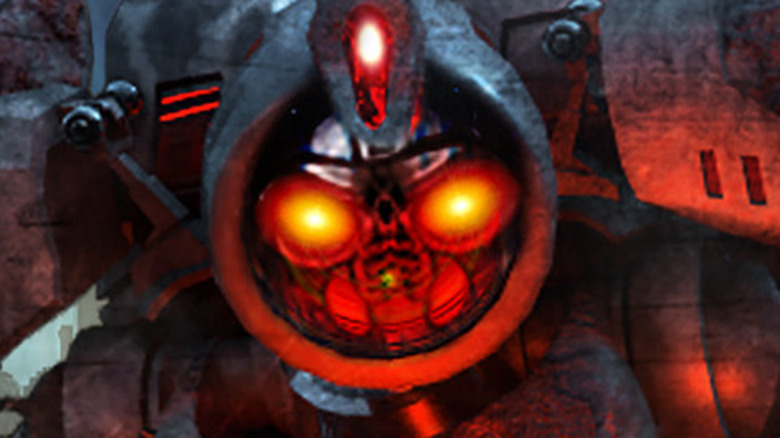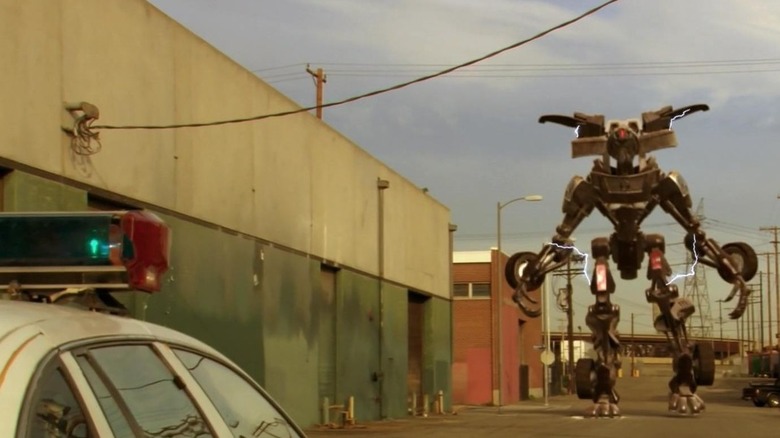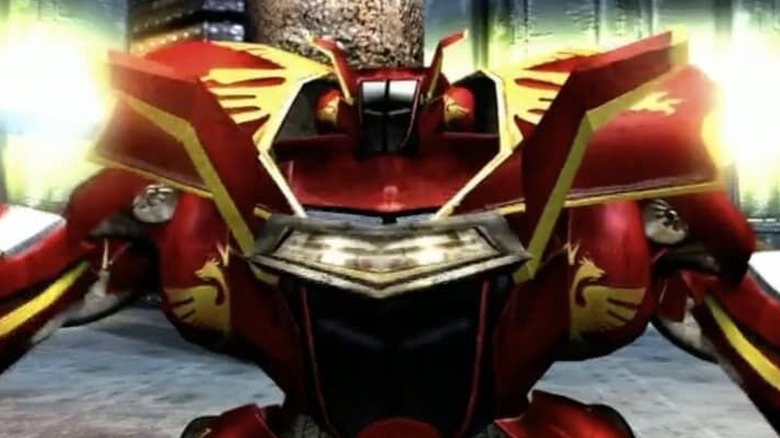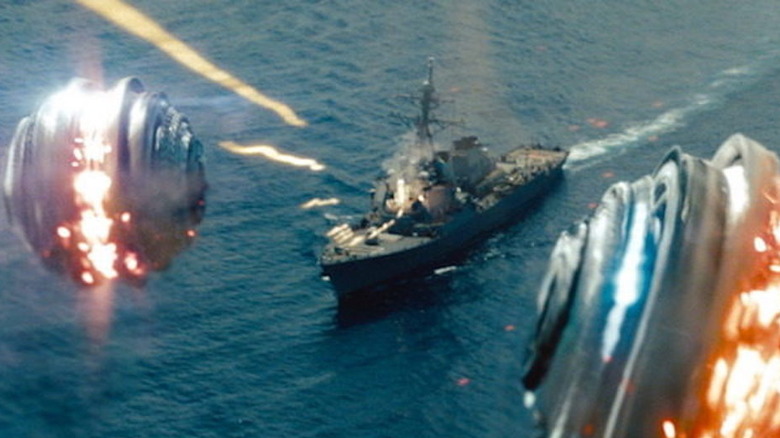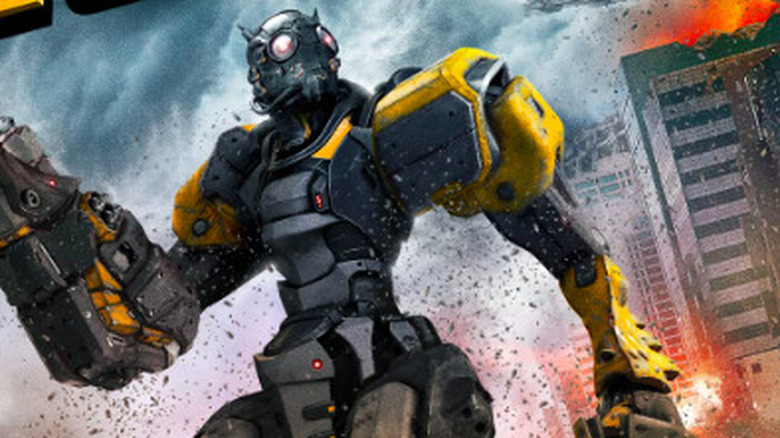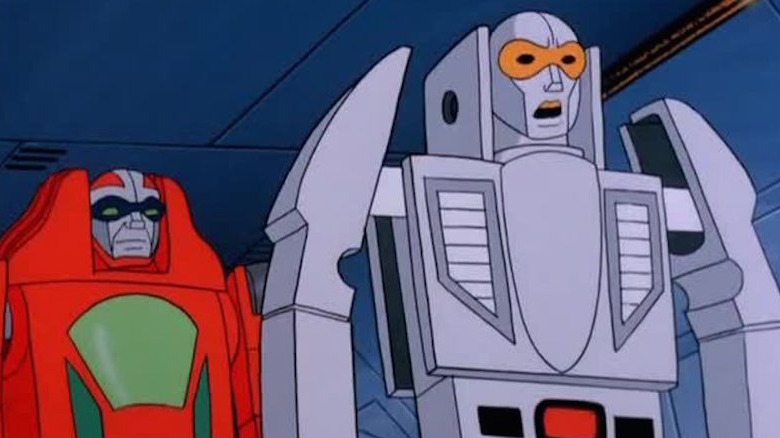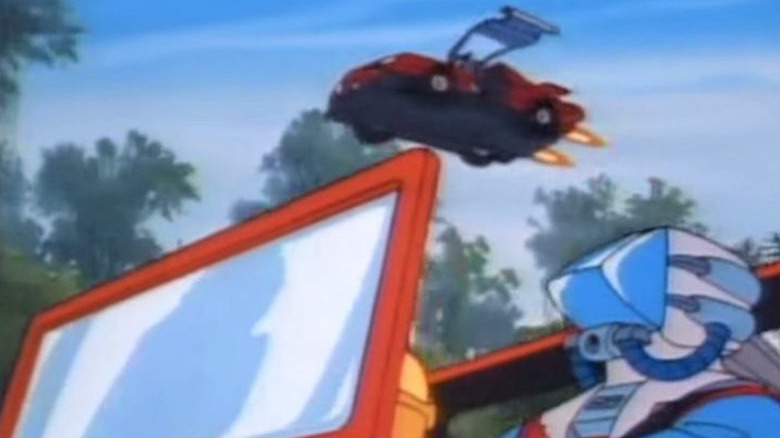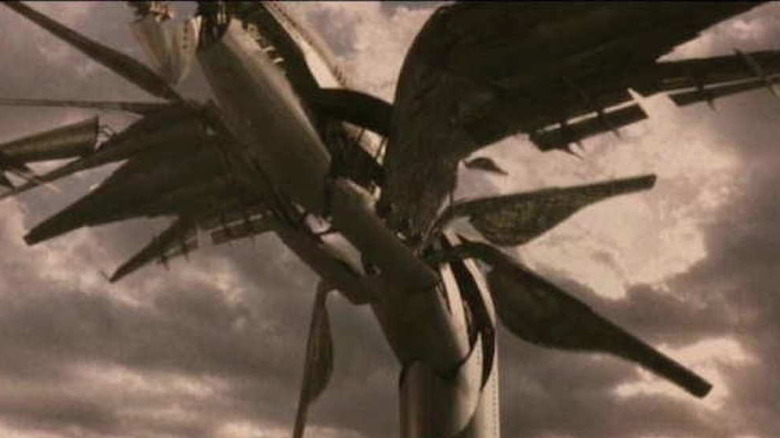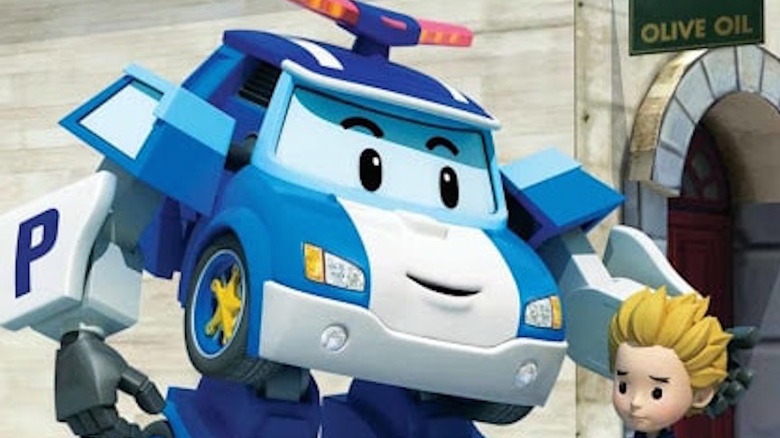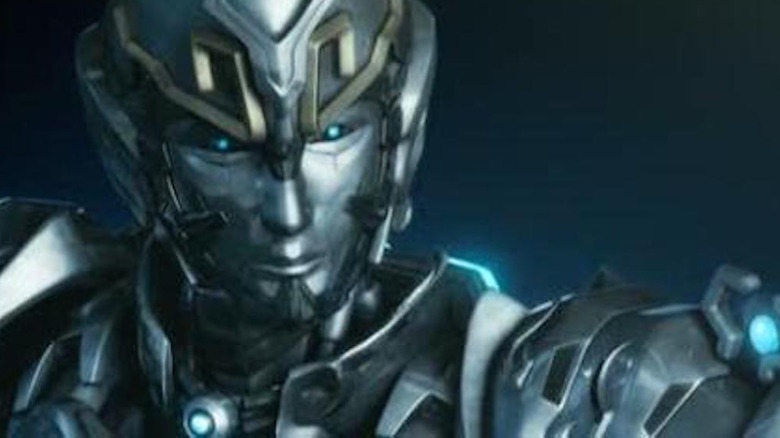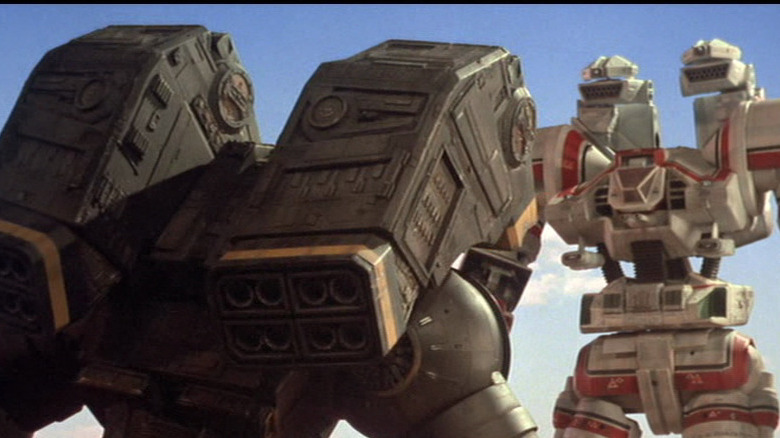The Most Ridiculous Transformers Rip-Offs That Actually Happened
It's become a standard in the entertainment industry: a major studio feature, heavy on the special effects, is released, and a few months later, the home viewing audience is usually treated to the "mockbuster" version — a low-budget revamp that borrows heavily from its source material. Some production entities, like The Asylum, have made it their primary purpose to issue such films, and have attracted worldwide attention with their threadbare efforts.
Very few movie franchises have escaped mockbuster treatment: the Marvel Cinematic Universe has its clones ("Avengers Grimm") as does DC ("Sinister Squad"), the "Star Wars" franchise ("Battle Star Wars"), Disney ("CarsGo," "The Little Cars"), and even the "Paranormal Activity" series (the "Paranormal Entity" quartet). Add to that list Hasbro's "Transformers" media juggernaut, which has been the subject of knock-offs, carbons, and direct swipes since its debut in the early 1980s.
Like other mockbusters and copies, the "Transformers" rip-offs rarely dig deeper into their source material than a few CGI robots. Some take their cues from the dizzying array of characters and capabilities in the toy line and animated productions, while others simply ape the go-for-broke barrage of special effects seen in the live-action "Transformers" films. Following is a list of movies and television series which did their best to siphon off some of the Allspark that fueled the success of "Transformers."
Transformers? No, sorry -- Transmorphers
The 2007 direct-to-video title "Transmorphers" is the product of mockbuster specialist studio The Asylum, which has carved a niche for itself in the entertainment industry by producing very cheap and frequently (if unintentionally) hilarious carbons of major theatrical releases. Chances are, you may have accidentally stumbled upon one of their movies during a late-night scan of streaming titles, believing that you selected "Thor" or "Pacific Rim" only to discover that you'd accidentally exposed yourself to the threadbare charms of "Almighty Thor" or "Atlantic Rim."
To its credit, "Transmorphers" doesn't try to compete with "Transformers," or even resemble it beyond a few passing coincidences. There are giant transforming machines, but these robots in disguise hew closer to the hunter-killer machines of "The Terminator" than Autobots and Decepticons. Director Leigh Scott siccs his C-minus CGI robots –- called Z-bots — on humanity within the first few minutes of the film and drives them underground. The survivors decide to capture a Z-bot and rewire it for their own purposes, thawing out super soldier Matthew Wolf to carry out the mission. This being an Asylum picture, there's also a ludicrous, left-field wrinkle in the plan.
Despite a budget-strapped attempt at a Big Battle, the Transmorphers were back two years later in "Transmorphers: Fall of Man." This prequel envisions an invasion by aliens who turn our electronic devices against us. If you've ever wondered what kind of damage a transforming mobile phone might do, "Fall of Man" gives you the chance to find out.
Are you not entertained by Gladiformers? Probably not
The 2007 animated feature "Gladiformers," from Brazilian animation studio Video Brinquedo, takes a curious approach to which elements it decides to adopt (read: rip off) from "Transformers." It swipes the transforming robot premise, and even gives its main characters names that sound like "Transformers" characters: the main bots are named Julius Drive and Magnum Tutor, which sounds like "Optimus Prime" and "Megatron" if you have marbles in your mouth. But beyond that, "Gladiformers" takes its own half-baked route, which envisions a future world where robots are kidnapped and forced to fight in an arena to secure their freedom. Sounds more like "Gladiator," but if you've willingly surrendered to a Brazilian "Transformers" knock-off with '90s-era PC game-level animation, that's probably not going to trouble you — nor will the fact that Video Brinquedo released a sequel in 2009.
Video Brinquedo, or Toyland Video as they were known in the States (the company went bankrupt in 2012), released a slew of poorly animated CGI titles in the early to mid-2000s, all drawing heavily upon American animated features. Actually, they mostly draw on the taglines: "The Little Panda Fighter," which is Brinquedo's take on "Kung Fu Panda," features a bear that boxes but secretly wants to dance, while "Ratatoing" — their attempt at "Ratatouille" — does have rats with a passion for cooking, but also adds a dumb cat, a trio of bad mice, and some truly hideous-looking animated food passed off as gourmet meals.
Battleship sunk itself
Hasbro Studios/Allspark's lamentable 2012 film "Battleship" attempted to do for the company's board games what the "Transformers" film series did for its robot toys. The film closely copied the production model of the "Transformers" titles — fresh-scrubbed young cast (led by Alexander Skarsgard and Rihanna), big explosions, CGI aliens -– but failed to reproduce its box office take.
"Battleship" isn't a direct rip-off of "Transformers" — its alien menace, which battles the U.S. Navy for the fate of the world, is armored and aggressive but doesn't transform. Yet it borrows so heavily from its predecessor's template that the two films almost seem to be companion pieces. Director Peter Berg ("Friday Night Lights") does what he can to inject notes of suspense or pacing, or allow the actors to act, but has little room to do so amidst all the big booms and bangs.
In truth, "Battleship" probably never had a chance, even without the overtures to "Transformers." As the makers of "Clue" could have told them, a board game is difficult material on which to base a movie. But the failure of "Battleship" didn't steer Hasbro away from turning its properties into motion pictures. They tried against two years later with "Ouija" and scored a modest horror franchise from it.
Hornet: like Bumblebee, just completely different
Proving that no aspect of the "Transformers" franchise is safe from mockbuster treatment, The Asylum issued "Hornet" in 2018 to capitalize on the success of "Bumblebee." As with previous Asylum efforts, "Hornet" takes a few bullet points from its source material: there's a yellow robot, a female lead (several, actually), and a threat from outer space.
Where "Hornet" deviates from "Bumblebee" is its storyline and approach. Here, the faux-Former is a science project created by a gaggle of college students. Its invention times out perfectly with an invasion by aliens who turn citizens into zombies. It's worth noting that the film's heroes handle much of the interaction with the zombies and aliens. Hornet more or less looms over the action unless the chips are really down, which prompts some low-wattage firepower.
Directors the Kondelik Brothers — veterans of low-budget and mockbuster titles like the astonishing "Snake Outta Compton" — choose to frame Hornet's adventures as a found footage movie. It does nothing to improve the film's pacing or suspense, but does offer a degree of novelty to the proceedings.
GoBots: the Transformers knockoffs who came first
The perennial bridesmaid in the robot toy universe, the GoBots have earned a reputation as a cheap knock-off of Hasbro's Transformers. In truth, the GoBots preceded the Transformers: a joint production between Tonka and a now-shuttered division of Bandai called Popy of Japan, the GoBots (originally named Machine Robo) arrived in stores in 1983 -– one year before the Transformers.
Once Hasbro issued the Transformers, however, the GoBots didn't stand a chance. Popy's simplistic design couldn't hold a candle to the Transformers' complex array of moving parts. Adding insult to injury: the first generation of GoBots stood just two to three inches tall -– about half the height of the average Transformers. By the time Tonka got around to issuing the larger Super GoBots, it was all over but the shouting.
Tonka's last-ditch attempt to bring some degree of respectability to the GoBots was a cartoon, but again, they found themselves outdone at every turn. "Challenge of the GoBots" aired in syndication, but even the efforts of producers Hanna-Barbera couldn't save it from immediate dismissal by kid viewers: how else to regard obvious imitations like the Bumblebee carbon Bugbite, or Stretch, which transformed from a limousine to a robot... with a top hat? The 1986 feature film "GoBots: Battle of the Rock Lords," which introduced the spin-off Rock Lords, didn't help the toy line's downward spiral. Hasbro delivered the coup de grace for GoBots by purchasing Tonka and the characters' names and backstories in 1991, though Bandai retained ownership of the toy molds.
Transformers + G.I. Joe = M.A.S.K.
The success of the "Transformers" animated series spurred a number of other companies to try their hand at a show featuring robots, transforming vehicles, or a combination of the two. "Challenge of the GoBots" followed the "Transformers" blueprint to the letter, while the syndicated "M.A.S.K." ran a close second in the carbon copy department. The show, produced by DIC Enterprises — home to "Inspector Gadget" and the "Mighty Morphin Power Rangers" — was based on a toy line by Kenner, which invited kids to join in the battle between M.A.S.K. (Mobile Armored Strike Command) and V.E.N.O.M. (Vicious Evil Network of Mayhem), for which there could never be enough adjectives, it seems.
While the warring sides on "M.A.S.K." were clearly based on Hasbro's "G.I. Joe," the "mobile armored" part of the equation drew from "Transformers." Both sides piloted an array of cars and trucks which could also morph into various military vehicles: M.A.S.K. leader Matt Trakker alone had a Camaro that turned into a fighter jet, and (curiously enough) a fighter jet that turned into a car, albeit with rockets.
"M.A.S.K" ran for a single season on TV, but has retained a loyal following. Hasbro, which purchased Kenner in 1991, revived "M.A.S.K," along with many of its other media franchises, for "Unit: E," a one-shot comic created for the 2011 New York Comic-Con. IDW later issued a "M.A.S.K." comic which, at one point, partnered the wheeled good guys with — you guessed it — the Transformers.
Returner believes imitation is the sincerest form of flattery
Takashi Yamazaki's feature "Returner" borrows from so many popular American sci-fi franchises — in addition to "Transformers," the 2002 Japanese film lifts liberally from "The Matrix," "The Terminator," "E.T," and a half-dozen yakuza and anime titles — that one critic likened it to watching a "chirpy tribute band." It's an accurate analogy, and as with many tribute bands (chirpy or otherwise), watching "Returner" can be a lot of fun if you accept its intent (maximum fan tribute) for what it is.
That doesn't mean that the onslaught of sci-fi tropes doesn't turn ridiculous at times. Star Takeshi Kaneshiro overdoes the brooding hitman routine, and the intersection of references can, at times, produce a dizzying sensation. Case in point: the film's nod to "Transformers," when a jet airliner dramatically morphs into an alien spacecraft and gracefully disgorges its crew. It's well executed, but piled atop a cinematic plate already full of bullet time FX, time travel and blazing gun battles, it breaches the gap between excessive and absurd.
Robocar Poli is like Transformers Jr.
Calling "Robocar Poli" a "Transformers" rip-off may seem a bit like kicking a puppy — the South Korean series is, after all, a brightly-colored and lively animated program for pre-schoolers — but facts are facts: the mechanical residents of the show's small town setting (Brooms Town) are vehicles that can transform into squat, smiling robots in order to rescue the steady stream of children, cars, trains, and other modes of transportation that fall afoul of trouble with alarming regularity.
"Robocar Poli" features a cast of morphing motors that's as diverse as the Transformers universe. Virtually anything with wheels gets its own Robocar iteration on the show, including old-school Lincolns, tuk-tuks, and a dump truck with the unfortunate name of Dumpoo. The series also has its own take on the Decepticons –- Truck-X and Poacher the jeep –- though even Megatron would pause before indulging in their particular brand of villainy: Truck-X kidnaps other vehicles (!), while Poacher hunts animals. Thankfully, the series' lead, genial cop car Robocar Poli, and his pals brought them both to justice.
Kungfu Cyborg is just your average rom-com action sci-fi film
Hong Kong multi-hyphenate Jeffrey Lau has one of the most unique resumes of any filmmaker, Chinese or otherwise: he's produced crowd-pleasing comedies like "Kung Fu Hustle," arthouse pictures like Wong Kar-Wai's "Ashes of Time," and gonzo genre hybrids like "Haunted Cop Shop." His 2008 feature "Metallic Attraction: Kungfu Cyborg" falls into the latter category by folding "Transformers"-style robots into a broad spectrum of sci-fi, slapstick comedy, satire, and romance.
"Cyborg" stars Hu Jun as a police officer tasked to oversee K-1 (Alex Fong), an android cop who inexplicably resembles a '50s-era rockabilly singer. K-1's supercool exterior and array of abilities — which range from flight and incredible speed to transforming into a motorcycle — aggravate Jun, especially when K-1 catches the eye of his secret crush, fellow officer Sun Li.
Eventually a T-1000-style rogue android (played by Wu Jung) shows up to remind viewers that this a sci-fi/action film. Like K-1, the bad android has transformative powers, and the pair engage in some frantic morph-and-fight sequences. But this is just the tip of the "Transformers" iceberg: Hu Jun is killed in the fracas and transformed into an android using spare parts from the defeated Wu Jung. The souped-up Jun joins forces with K-1 in an even more frenzied battle with government forces that includes, at various times, a giant robot made from junk that resembles the jiangshi (Chinese hopping vampire) and generates mechanical spiders that transform into coffins — all the better to defeat an army of AI gangsters produced by Wu Jung. You read all of that correctly.
Robot Jox features fighting Transformers-style 'bots
"Re-Animator" director Stuart Gordon delivered one of the wildest "Transformers" knock-offs to date with his 1990 feature "Robot Jox." The film — which was completed in 1987, but waited three years in limbo followed the collapse of producer Charles Band's Empire Pictures -– envisions a brutal future where international conflict is settled with gladiatorial fights featuring colossal robot warriors. Gordon sets the tone for the picture in its early scenes when a fight between American and Soviet robots goes awry and hundreds of spectators are crushed in gory fashion.
Gordon initially conceived the film with noted science fiction author Joe Haldeman, who viewed the story as dark, serious science fiction. To Haldeman's chagrin, Gordon rewrote much of the final script to lighten the tone and shift the focus to the robot fights. Haldeman shouldn't have worried: despite plentiful action, stop-motion effects by David W. Allen and uncredited robot designs by Ron Cobb, "Robot Jox" was dead in its tracks following Empire's collapse. The film eventually saw a brief theatrical release in 1990 before disappearing into the home video void.
Incredibly, "Robot Jox" spawned two knock-offs of its own, albeit ones overseen by its producer, Charles Band. He directed 1990's "Crash and Burn," which was titled "Robot Jox 2" for its European release, despite the fact that the only connecting factor between the films is a giant robot. Band then returned to the robot fold in 1993 for "Robot Wars," which also featured fighting robots in a different but still dystopian future.
